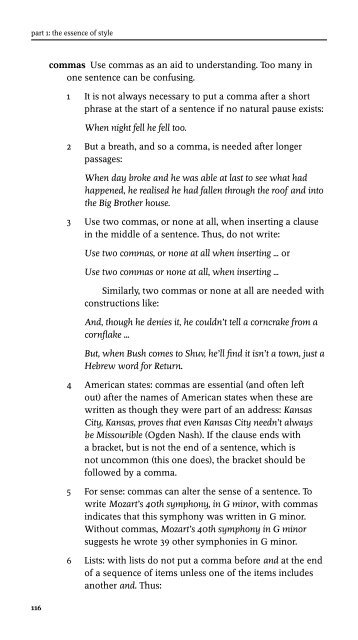Economist Style Guide - Redress Information & Analysis
Economist Style Guide - Redress Information & Analysis
Economist Style Guide - Redress Information & Analysis
You also want an ePaper? Increase the reach of your titles
YUMPU automatically turns print PDFs into web optimized ePapers that Google loves.
part 1: the essence of style<br />
116<br />
commas Use commas as an aid to understanding. Too many in<br />
one sentence can be confusing.<br />
1 It is not always necessary to put a comma after a short<br />
phrase at the start of a sentence if no natural pause exists:<br />
When night fell he fell too.<br />
2 But a breath, and so a comma, is needed after longer<br />
passages:<br />
When day broke and he was able at last to see what had<br />
happened, he realised he had fallen through the roof and into<br />
the Big Brother house.<br />
3 Use two commas, or none at all, when inserting a clause<br />
in the middle of a sentence. Thus, do not write:<br />
Use two commas, or none at all when inserting … or<br />
Use two commas or none at all, when inserting …<br />
Similarly, two commas or none at all are needed with<br />
constructions like:<br />
And, though he denies it, he couldn’t tell a corncrake from a<br />
cornfl ake …<br />
But, when Bush comes to Shuv, he’ll fi nd it isn’t a town, just a<br />
Hebrew word for Return.<br />
4 American states: commas are essential (and often left<br />
out) after the names of American states when these are<br />
written as though they were part of an address: Kansas<br />
City, Kansas, proves that even Kansas City needn’t always<br />
be Missourible (Ogden Nash). If the clause ends with<br />
a bracket, but is not the end of a sentence, which is<br />
not uncommon (this one does), the bracket should be<br />
followed by a comma.<br />
5 For sense: commas can alter the sense of a sentence. To<br />
write Mozart’s 40th symphony, in G minor, with commas<br />
indicates that this symphony was written in G minor.<br />
Without commas, Mozart’s 40th symphony in G minor<br />
suggests he wrote 39 other symphonies in G minor.<br />
6 Lists: with lists do not put a comma before and at the end<br />
of a sequence of items unless one of the items includes<br />
another and. Thus:


